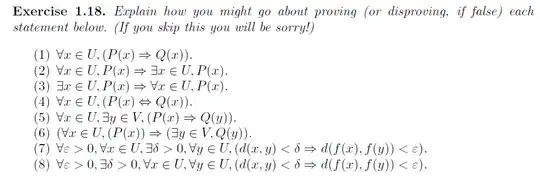Hey guys, need some help here. I was told by your instructor that there are three methods of proof: (1) direct, (2) by contraposition, and (3) indirect (by contradiction). There is also a technique of proof by mathematical induction. A counter-example is essentially a proof that a statement is false, but it requires existence; that is, a counter-example must be specific and name individuals and sets.
However, I am unsure about how to proceed. First few statements looks like it can be proved directly using U as a statement such as "a set of prime numbers from 0-10" and then we can say that P(x) as {2,3,5,7} but I dont know how to deal with Q(x).
What about statements (7) and (8)? those two are conditions or statements of continuity and uniform continuity which I studied in advanced calculus. Should those proofs be straight forward? I am little confused with those since the course is topology and its a question of topology.
Any help will be greatly appreciated. Thanks in advance!!
